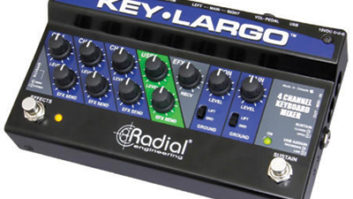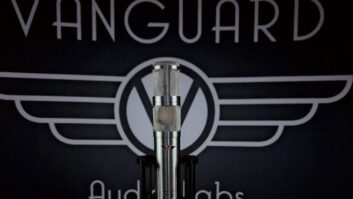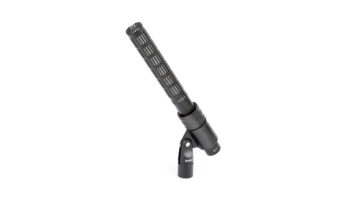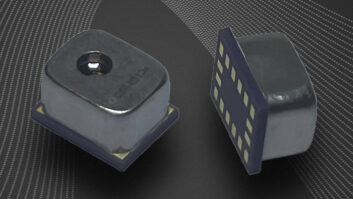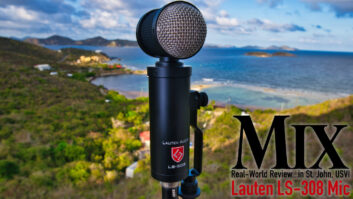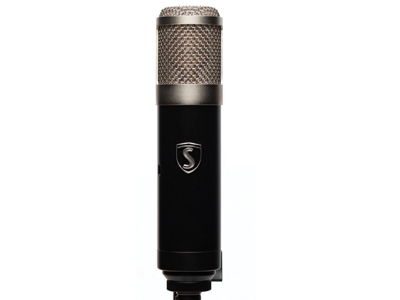
Since the 1980s, the name Soundelux has meant many things, with the brand evolving from a sound design company to an award-winning library to a provider of dozens of services touching all areas of the audio industry. Part of that legacy is David Bock, whose penchant for mic design can be traced back to his work repairing holy-grail vintage mics at various California studios.
Since his time at Soundelux, and eventually starting his independent brand, Bock Audio, his philosophy of producing quality, handmade, boutique microphones at reasonable prices has been responsible for some modern classics. His latest offering, the Soundelux USA U99, is the second Soundelux USA-branded mic since Bock’s acquisition of the brand name in 2016.
The original Soundelux U99 was produced from 1999 through 2006, and, like the original, the new mic features a K67 dual-backplate capsule allowing adjustable polar patterns. Also echoing one of the most interesting features of the original, the polar pattern adjustment control, found on the power supply, is continuously variable from Omni to figure-eight. It is not stepped or detented.
The U99 takes a turn with its vacuum tube, using a NOS Philips 5840w subminiature pentode run as a triode. The 5840s are a currently a popular choice in pencil condensers like the Telefunken ELAM 260 or Mojave MA-100 because of their small size. Like the Soundelux USA U195, the U99 features a “Fat” switch. On the U195, this was a low-frequency boost. According to Bock’s description, the U99’s Fat switch plays more of a role in affecting the bias of the tube to alter the low-frequency character of the mic. Other bells and whistles include a pad and a high-frequency tilt, which can boost or attenuate the top end, with a two-position adjustable frequency selector when used as a cut. These controls are active circuits, which are truly bypassed when set to the “flat” position.
GUITARS, VOICE, CELLO, BONES
My first use of the U99 was an overdub ses- sion recording electric and acoustic guitars. I set up the U99 about a foot-and-a-half away from the acoustic guitar pointed just about where the neck met the body. I had all of the switches set flat and the polar pattern set to cardioid. When listening, the guitarist started out playing big, jangly chords, with some staccato palm-muting in between. The first thing that caught my ear was how snappy the sound was. The mids had this unique thick, tight attack, and the top end was detailed but very smooth and non-abrasive.
We moved on to electric guitar, first recording a low staccato riff with a clean amp tone. The Soundelux USA U99 was about a foot away from the amp, just slightly off axis, and again, this fat, punchy, warm tube sound came through. The low end had a nice “thunk” to it, and the highs were clear, de-tailed and anything but harsh. Out of curiosity, I engaged the Fat switch to see what it would do, and the most noticeable effect, in this case, was that the sound started to break up a little bit in the low end. Desiring a cleaner tone, we took the Fat switch off. Later, when using a slightly dirty tone on the amp, the Fat switch added a nice subtle but noticeable punch to the low end. The overall sound was warm, punchy and nostalgic, like a ’60s feel but with a more modern low end.
The Fat switch shined on heavily distort- ed palm-muted guitars. This time the effect was not subtle, as it seemed to change the overall character of the signal completely. In normal mode, the guitar sounded great. It was thick and tight, and the top end had a nice bright sheen. After engaging the Fat switch, however, the lows picked up this tightly compressed sound that lifted them out from the signal in a controlled manner.
Next, I tracked vocals with a male baritone singer. In each take, the mic took to the low midrange of his voice with clean, clear, swelling sounds, falling short of being boomy. The sound seemed too dark on top to pop in the track, but turning on the high-boost switch made a difference, though it was still too subtle to get him cutting through. Boosting top-end EQ when tracking with a tube mic is often a dangerous proposition because many tube mics have a hissy self-noise, but that did not seem to be the case with the Soundelux USA U99. After adding some EQ, I realized that this was one of the quietest tube mics I’ve heard.
I tried using the Fat” switch with the singer, but it didn’t help the cause. If anything, it brought out a lot of plosives and got in the way. On an announcer-type voiceover, on the other hand, the Fat switch was a nice trick. The results weren’t nearly as profound as what I had heard on that blistering guitar track, but it made a positive difference that was accentuated when adding compression and subtle equalization. As with the guitar, it lent a punchy, percussive sound to the low end and pushed the consonants, in both cases with a desirable restraint.
One of my favorite uses was miking a solo cello. The mic was backed about two feet from the instrument, pointed between the f-hole and the bridge. When the cellist bowed her first note, everyone’s jaw dropped in the control room. The low end enveloped the room, but the top end was velvety smooth. The tracking room was a bit dead, so with a little reverb, the sound was pretty perfect, with no equalization.
Recording bass trombone was one appli- cation where the top end got to be a little harsh and warranted the use of the high-fre- quency cut switch. The switch engages an additional circuit that can center the high-frequency shelf at either 5 kHz or 2.5 kHz. In either case, the effect was relatively subtle and ultimately necessitated position- ing the mic pretty far off axis from the bell pointed downward towards its opening. The resultant sound was that same thickness that I had heard on guitars with a tame and pleasant growl.
It is worth noting that the output of the mic was pretty hot, even with the pad switch engaged. In the case of recording bass trombone, as well as electric guitars, I typically had to pad the mic preamp in addition to engaging the mic’s own pad just to avoid clipping the converters.
A NEW CLASSIC?
Altogether, this microphone is the ultimate studio workhorse. It always produces a great-sounding recording and never gets subbed out once it goes up. It’s obviously a lot more affordable than a vintage U67, and won’t give you that same fear or apprehension when it comes out of the locker. With all of its settings, it also provides a much wider range of sounds than a U87, while coming in at a lower price tag. If you’re looking for a flagship mic to build your locker around, this should certainly make your top five. If it’s time to retire one of your Neumann clas- sics and you’re eyeing a young rookie for the future, this kid’s a first-rounder for sure.
